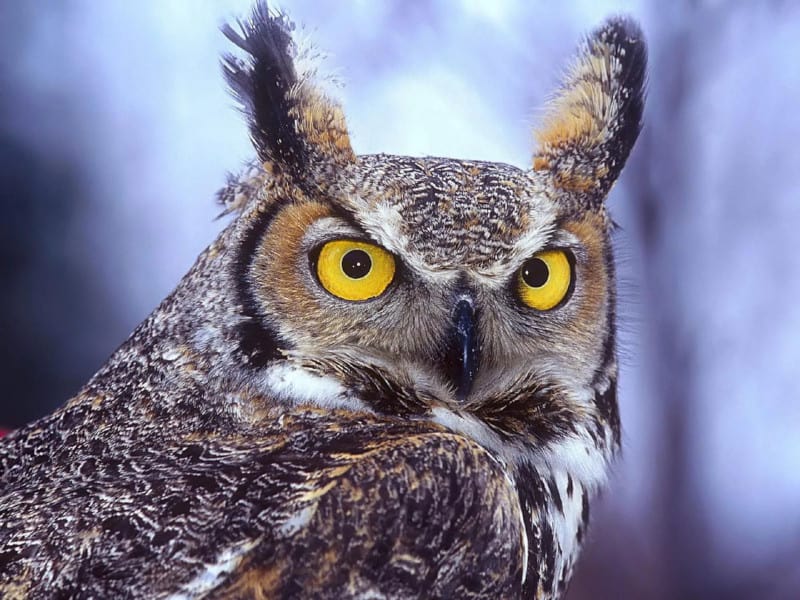
Long Eared Owl Facts
- Perhaps most notably, the descriptive term of Long Eared Owl serves as one of the common names for a truly majestic type of raptor. The animal does, however, also possess several other common names. These are used in various parts of its range.
- These alternate common names include several highly descriptive terms. They include such terms as the cat owl, the lesser horned owl, and the northern long-eared owl. This beautiful avian also goes by the scientific name of Asio otus, though.
- This gorgeous creature additionally shares a great portion of its native range with a related avian. That’s the visually quite similar species known as the short-eared owl. The two animals can most easily be distinguished while at rest.
- That’s because, at that time, the ear tufts of the Long Eared Owl become clearly visible. This constitutes the most easily recognizable physical difference between the two. In addition, the eyes of the two different creatures display different colors.
- A total of four recognized subspecies of this remarkable avian currently exist around the world. But, the Long Eared Owl has a decided advantage over many of them. Unlike some of them, this wonderful bird appears to have a sizable and stable population.
- Due to this, the IUCN presently lists it as a Species of Least Concern. This ranking appears on its Red List. It nonetheless must be considered to be facing at least a few threats to its existence. These would include habitat loss and climate change.
Related Articles
Oilbird Tawny Frogmouth Snowy Owl
Long Eared Owl Physical Description
Not surprisingly, the beautiful Long Eared Owl merits attention for other factors than merely its size. That holds true because the animal develops as an owl of only medium-to-large physical size. Generally, it does display a moderate of the trait of sexual dimorphism.
Individuals of this animal attain a fully respectable body size. Mature specimens average roughly 16 in (40 cm) in total length. Meanwhile, wingspans for most average about 39 in (100 cm). Adult body weight varies significantly, but averages around 15.3 oz (435 g).
The female of the stunning Long Eared Owl also typically grows larger and heavier than the male. These females also develop as darker in coloring. The extremely vertical ear tufts of both sexes generally develop as black in color, though, and centered on the head.
The prominent feathers of the bird also possess a visually striking pattern of colors. These usually appear as a light brown shade in color, with vertical darker stripes present as well. The impressive eyes of this stunning species also typically grow comparatively large.
- Kingdom: Animalia
- Phylum: Chordata
- Class: Aves
- Order: Strigiformes
- Family: Strigidae
- Genus: Asio
- Species: A. otus
Long Eared Owl Distribution, Habitat, and Ecology
Much like many related species, the breathtaking Long Eared Owl evolved as partially migratory in nature. However, to the surprise of many people, this avian inhabits a relatively broad swathe of the globe. That’s due to the fact that it appears on three separate continents.
More precisely, however, the marvel appears on a total of three separate continents. These consist of the continents of Asia, Europe, and North America. The fascinating animal commonly generally moves southward within its native range during the winter months.
The stunning raptor also has decided preferences for the type of region it chooses for its habitat. This holds true since individuals primarily inhabit forests that developed close to open areas. That further provides a combination of protective cover and good hunting.
Most individuals typically make nests in coniferous trees. During breeding season, this activity occurs between February and July, and clutches average 4-6 eggs. The marvelous Long Eared Owl also shares one particular behavioral characteristic common to all owls.
That’s the fact that it generally hunts at night. Even among its kindred, this animal stands out for its skill as a hunter. The raptor remains renowned for being virtually silent while hunting. Its principal prey consists of a variety of small mammals, rodents, and other birds.
Species Sharing Its Range
Wood Frog Scottish Wildcat Saola
Check out our other articles on 5 Fabulous Deer Varieties, Barreleye Fish, Fingal’s Cave, Black Sea Hare, Snow Leopard, Naked Man Orchid, Green Sea Turtle, Fire Salamander

